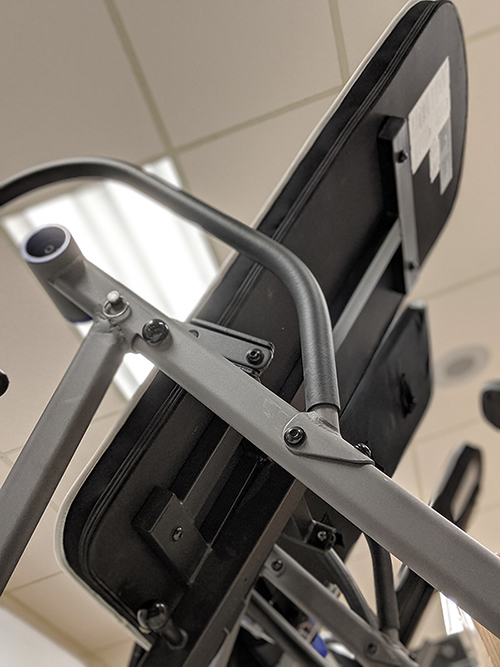Utah, 2002: A Jeep Wrangler towed by a motor home came loose and struck an oncoming 1993 Mazda MPV minivan head on. Thanh Williamson, 32, seated in the rear center seat of the minivan, died as a result of abdominal injuries and internal bleeding sustained from the lap seat belt she wore. Her husband and daughter, Ondi and Alexa Williamson, in the driver’s seat and rear side seat, wore lap-shoulder belts and survived the collision. Alexa, seated next to her mother, was seven.
In 2004, after reaching a settlement with the driver of the motor home, the Williamson family filed suit in California’s Orange County Superior Court accusing Mazda of negligence, product liability, and wrongful death. The suit claimed the automaker should have installed a lap-shoulder belt in Mrs. Williamson’s seat to restrain her upper torso in a frontal collision. Lawyers for the Plaintiff were David R. Lira, Thomas Girardi (LA, www.girardikeese.com), and Martin N. Buchanan (San Diego, www.martinbuchanan.com).
The state trial court dismissed the action on the ground that it was preempted under the 1989 version of the Federal Motor Vehicle Safety Standard 208 (FMVSS 208), which permitted auto manufacturers to choose whether to install lap belts OR lap-shoulder belts on rear inner seats such as the one Thanh Williamson had been using.
In 2008, Williamson’s attorneys brought the case to the California Court of Appeal, which affirmed the Orange County Superior Court ruling, holding that the suit, if successful, would deprive auto manufacturers of the FMVSS 208 choice of which type of seat belt to install in rear inner seats.
In 2010, when the California Supreme Court declined to review the Court of Appeal decision, Williamson’s attorneys took the case to the U.S. Supreme Court. In a friend-of-the-court brief, the Office of the Solicitor General said Williamson should be allowed to sue Mazda. During oral arguments, attorney William Jay, assistant to the Solicitor General, said Mazda complied with the federal minimum standard by installing a lap seat belt, but argued the automaker should not be exempted from the consequences of its seat belt choice under state common law.
In 2011, after hearing all arguments, on February 23, 2011 the US Supreme Court issued a decision unanimously reversing the suit’s dismissal, asserting the Williamson family could sue Mazda. The court determined that Federal Motor Vehicle Safety Standard 208 does not preempt a state lawsuit that alleges a defective seat belt design.
In 2013, the case went back to California and then, at Mazda’s request, to Utah’s 6th District Court. Utah attorney Richard D. Burbidge (www.burbidgemitchell.com) joined the Plaintiff’s representation and spent years preparing the case for trial.
In 2014, as the Williamson’s suit against Mazda went forward, Hayes+Associates, Inc, was retained on behalf of the family to provide biomechanical analysis of the incident and injury. Based on that analysis, H+A CEO Wilson C. “Toby” Hayes, PhD, demonstrated at a 2017 hearing challenging the admissibility of his testimony, that the severe abdominal injuries that led to Thanh Williamson’s death resulted directly from concentrated restraint forces and the associated jack-knifing of her body over the lap belt. Analysis by former Senior Associate, Mark S. Erickson, now of Erickson Forensic (https://ericksonforensic.com/), and testimony by Dr. Hayes, concluded that if Thanh’s seat had been equipped with a lap-shoulder seat belt, her fatal abdominal injury would not have occurred. Shortly after the hearing, the Court ruled that Dr. Hayes’ testimony was admissible and could be used at trial.
Shortly thereafter, a confidential settlement was reached before the case went to trial.
In November of 2017, Lira, Girardi, Buchanan and Burbidge were named 2017 California Consumer Attorneys of the Year in recognition of their successful 13-year pursuit of the landmark change in seat belt safety requirements.
Far-Reaching Effects of Williamson v. Mazda
In a 2018 interview with The Salt Lake Tribune, Ondi Williamson said, “When a loved one passes away, you want a legacy. This is Thanh’s legacy, the Supreme Court decision. A lot of people are protected because of our loss.”
(https://www.sltrib.com/news/2018/01/15/how-a-utah-womans-car-crash-death-led-to-a-precedent-setting-us-supreme-court-decision-on-seat-belts-and-continuing-pain-for-her-family/ )
Hayes describes Williamson v. Mazda as “a decision of potentially sweeping import.” The case was instrumental in rewriting seat belt requirements that had previously allowed auto manufacturers to use dangerous restraint designs under the protection of Federal Standards.
David R. Lira, attorney for the Williamsons, notes that the “decision will likely reverberate in other areas of the law as well…(and)…could become important in a wide variety of other types of products liability cases involving federally regulated products.” (https://www.girardikeese.com/News-Media/Preempting-Preemption-An-Analysis-of-Williamson-v-Mazda-Motor-of-America-Inc.shtml )
Hayes+Associates, Inc. (http://www.hayesassoc.com) is an expert witness and consulting firm based in Corvallis, OR. The company brings more than 75 years of collective experience in academic research, university teaching and forensic testimony to practice areas that include vehicle collisions, premises safety, slips and falls, products liability, worker safety, sports and recreation, patent litigation and criminal matters.





